Text
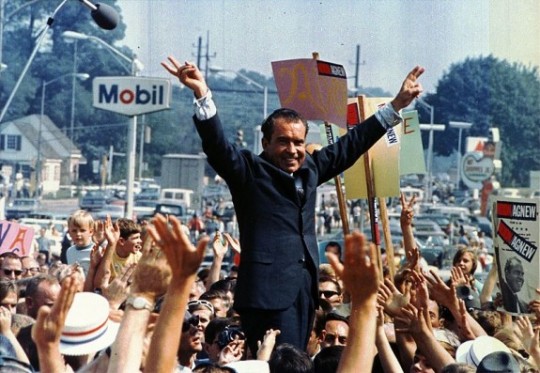
As the 1960s rolled to a close and with the Vietnam War proving itself to be increasingly unpopular amongst the American public, in 1968 President Lyndon B Johnson began secret talks with the North Vietnamese to begin the process of ending the conflict.
Unfortunately for the people of Vietnam and... pretty much everyone directly involved, Richard M Nixon was running on a platform of ending the war as well at the time and the Vietnam War ending too soon under a Democratic president wouldn't do his campaign any good... So naturally, the staff in Nixon's election team were instructed to sabotage the proceedings.
In a telephone conversation with H. R. Haldeman, an aide who would go on to become White House chief of staff, Nixon gave instructions that a friendly intermediary should keep “working on” South Vietnamese leaders to persuade them not to agree to a deal before the election, according to the notes, taken by Mr. Haldeman.
Additionally, it was discovered via the FBI bugging the phone calls between the South Vietnamese ambassador and of Anna Chennault, one of Nixon’s aides, that she had been advised to do the same things ahead of prospective peace talks that were planned to take place in Paris.
Johnson, who habitually recorded his own telephone conversations, is on tape as having been aware of what Nixon and his people were up to, and needless to say he wasn't exactly happy.
In the recently released tapes, we can hear Johnson being told about Nixon’s interference by Defence Secretary Clark Clifford. The FBI had bugged the South Vietnamese ambassadors phone. They had Chennault lobbying the ambassador on tape. Johnson was justifiably furious — he ordered Nixon’s campaign be placed under FBI surveillance. Johnson passed along a note to Nixon that he knew about the move. Nixon played like he had no idea why the South backed out, and offered to travel to Saigon to get them back to the negotiating table.
Despite it being a matter of record that Nixon's presential campaign was trying to prolong the very war he was promising to end, Johnson unfortunately chose not to make said evidence public. Partly because this would mean he'd have to admit to spying on the South Vietnamese ambassador, partly because he thought that his vice president Hubert Humphrey was a lock to win the next election so Nixon wouldn't be a problem anymore, and allegedly because Johnson believed that revealing Nixon's actions would cause the public to loose faith in the government...
Unfortunately, by the time the election finally rolled around, Nixon won the popular vote against Humphrey by just 1%. At that point, despite/due to placing Henry Kissinger in charge of the peace talks to end the war on Nixon's terms, the fighting continued for an additional five years with bombing spreading into neighbouring Laos and Cambodia, resulting in thousands more deaths.
As Robert Evans of the Behind the Bastards podcast put it on their series of episodes about Kissinger, the issue was basically that while Nixon wanted to get out of Vietnam, Vietnam wanted America out of Vietname, and the American public wanted America out of Vietnam, both Nixon and Kissinger didn't want to leave in a manner that made it look like they'd lost. Hence the escalation in fighting and bombing, because they'd gotten themselves stuck in a situation they had no easy solution to escape.
AND YET, it could have gotten worse.
In some tapes released by America's National Archives from 1972, between his complaining about Jews and liberals to Kissinger (yes, he was aware Kissinger was Jewish, yes he called him antisemitic stuff to his face), Nixon brought up a new suggestion...
Nixon is heard discussing an extension of bombing raids over North Vietnam with Henry Kissinger, the national security adviser. Then, rather abruptly, he says: "I'd rather use the nuclear bomb." Whether Nixon was serious or trying to provoke Mr Kissinger is not clear. In his baritone voice, his adviser replies: "That, I think, would just be too much." But Nixon then goes on: "The nuclear bomb. Does that bother you? I just want you to think big."
The Vietnam War eventually came to a close on 30th April 1975, seven years after Nixon sabotaged an attempt to begin ending the war sooner.
15 notes
·
View notes
Text
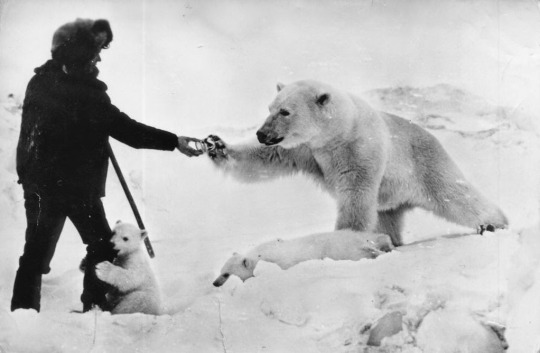
A surprisingly consistent thing in history is people coming up with plans involving enormous construction projects that are intended to have a short-term positive impact, which when looked at from both a modern perspective, would have enormously bad environmental impacts globally.
One such proposed plan came from the Soviet Union, where Derek Mead recounts how they at one point wished to melt the Arctic.
In an article for Motherboard, they wrote:
You might laugh, but while Soviet Russia was blessed with the largest land mass of any nation on Earth, much of it resource rich, putting that land to use was stunningly difficult.
…Russia was already spending an enormous amount of money combating the ice. Exploiting the vast petroleum reserves of the Arctic and Siberia was crucial to the growth of the Soviet economy, but every well pitted far-flung men against frozen earth and wind.
This meant that in order to exploit the resources they felt they required to properly compete with the USA, they needed to thaw Siberia. This is where a Soviet scientist named Petr Mikhailovich Borisov comes into the picture.
Borisov proposed building a 55-mile long dam that stretched from Russia to Alaska across the Bering Strait, potentially one of the largest, most expensive projects in history, with the intention of blocking the flow of cold water into the Arctic from the Pacific so the warm water from the Atlantic would over time cause the temperature in the Arctic to rise, thus melting the ice cap.
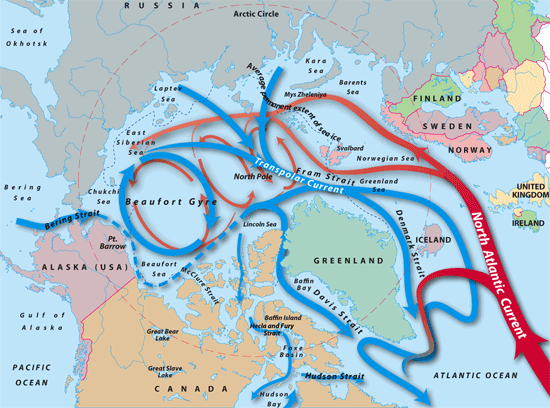
As bananas as this plan is, Mead contends that it nearly had America's support in the project, much the same way that the surprisingly similar plan to do the same in the 1800s did (albeit, that being an American plan to raise the temperature in America and Canada while freezing Europe).
Borisov dreamed of enlisting the US, Canada, Japan, and Northern Europe in the plan, as all would theoretically benefit from a warmer climate. Surprisingly, the US was intrigued by the idea. In fact, in a response to a series of questions sent in 1960 by the Bulletin of Atomic Scientists to presidential candidates Richard Nixon and John F. Kennedy, Senator Kennedy noted, as part of a larger point about the value of innovation in fostering cooperation, that the Siberia-Alaska dam was “certainly worth exploring.”
Amusingly this wasn't the only plan in this period to melt the Arctic as British scientist Julian Huxley, a cofounder of the United Nations Educational, Scientific and Cultural Organization (UNESCO), spoke at a conference in Madison Square Garden in 1945 about using nuclear bombs as “atomic dynamite [for] landscaping the Earth” (melting the polar ice cap).
Some have commented that considering the then recent bombings of Japan by the US this was in bad taste, but considering there were people who worked in the US government who repeatedly argued for "tactical" nuclear weapons usage (Henry Kissinger being one of them), I think that if there was enough public support behind it someone might have actually considered it.
8 notes
·
View notes
Text

Oh hey, it's Harry Houdini's 150th Birthday! To celebrate, here's a weird story I found.
A large part of the famous magician and escapologist's act appeared to be folk publicly challenging him to do a particular stunt, which as multiple instances of police departments claiming he couldn't escape their cells, usually as a mutual publicity stunt.
One of the more unusual examples of this came in 1911, when a group of 10 Boston businessmen challenged Houdini to escape from a "sea monster" while also chained hand and foot.
Houdini accepted the challenge, and thousands lined up outside of the BF Keith Theatre to see the magician escape what newsletters speculated was anything from a whale to a large turtle (it was the latter).
And, indeed, a lubricated Harry did escape the turtle, although as it had been embalmed with arsenic (one of the businessmen was a taxidermist), he did confess that in the 15 minutes it took to do so he nearly suffocated from the chemical fumes after an assistant help stuff the chained and handcuffed Houdini in the dead creature in the first place.
31 notes
·
View notes
Text

Despite the reputation that the Iron Maiden (a kind metal cupboard in the approximate shape of a woman with spikes on the inside) has as being one of the most distinctive old timey instruments of torture, there isn't actually any evidence they were actually used in the medieval period they supposedly hailed from?
Indeed, while there are accounts of various pointy boxes and statues used to harm people going all the way back to Ancient Greece, the first actual accounts of something called an Iron Maiden specifically only dates back as far as the 19th century, with the Iron Maiden of Nuremberg appearing in a museum in 1802 after being "discovered" supposedly in a German castle in the late 1700s.
It's a commonly believed theory that most supposed Iron Maidens in circulation and in museums are "replicas" (the Nuremberg Iron Maiden was destroyed by Allied bombing of the city during World War Two, with a copy made in the 1820s for exhibition in museums and side-shows being the one now available to look at). Things created by people thinking that they must have existed, because finding inventive ways to be mean to people is something had more time for back in the day.
So while it has been used as a prop and set dressing in much media about medieval times, the idea of an Iron Maiden specifically seems likely to be a comparatively recent invention or hoax people assume was in use back in the day, potentially a misinterpretation of something called a Schandmantel. This being approximately the same thing, but not spiky.
4 notes
·
View notes
Text

In 1913, Brooklyn-based engineer Carrol Livingston Riker approached the papers with a plan to solve the issue of cold winters in Canada and New England... by diverting the Gulf Stream that provides Western Europe with its temperate climate so that the warm ocean currents provide their benefits to the Eastern parts of North America instead, such as warmer winters and fewer icebergs.
The manner with this would be achieved, Riker states, would be by building a 200 mile long pier off the coast of Newfoundland along the Grand Bank to where the deep ocean begins, meaning that in places the pier would have to be some 300 plus feet deep in places.
Naturally the fact that this would plunge the British Isles and Western continental Europe into freezing winters that match those in Northern Canada (Britain being at the same latitude as places like Labrador, Canada) isn't lost on the writers of the article in the St Louis Star and Times, nor the fact that as Canada was a British colony at the time which the United States would have to potentially annex to complete the megastructure, but Riker considers the overall net good (for Americans) makes the benefits outweigh the costs.
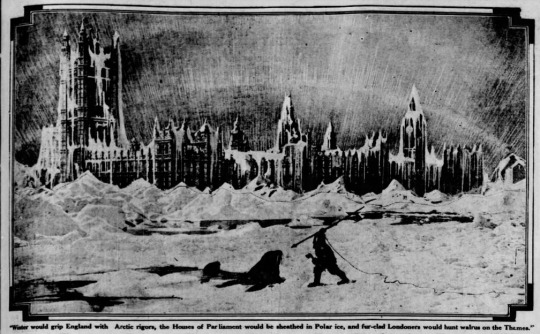
Despite the devastating climate catastrophe for Europe (the Star and Times amusingly suggesting that it could also cause the poles to shift) that could occur from this theoretical plan, Riker nonetheless received support from folk from both Harvard and Yale, in addition to the United States Naval Observatory, with the engineer also presenting his arguments so successfully to New York Representative Calder he attempted to introduce a bill to Congress to obtain funding for the project...
This did not actually happen, obviously, but it bring to mind a similar project first proposed in 1928 by German architect Herman Sörgel, which he named Atlantropa. Here Sörgel proposed damming and draining the Mediterranean, with the control flow of water through dams at Gibraltar and other points around the sea, which he theorised would create endless energy, new resources and uncovered land for people to settle in Southern Europe and Northern Africa.

However, much like Riker's pier, this would have ALSO created horrible climate change issues (rather than creating new farmland it would essentially turn the Med into a giant salt desert, which the sun would heat further causing the potential desertification of Southern Europe), technological issues with constructing the project in the first place, would have bankrupted all the countries that required access to the Med to trade, AND further opening up Africa and the Middle East to even more colonisation efforts by European powers.
16 notes
·
View notes
Text

It's perhaps unsurprising, but due to Albert Einstein's infamous socialist politics, pacifism, and anti-segregationist views did not endear him to the American establishment, even before he emigrated to the United States.
Starting with an attempt by the "Woman Patriot Corporation", an anti-feminist and antisemitic organisation comprised of establishment East Coast folk, who attempted to block his arrival to the United States with a variety of excuses ranging from his supposed Communist views to their objection with his theory of relativity itself, which they claimed was deliberately constructed to leave “… the laws of nature and the principles of science in confusion and disorder.”
Naturally as the Cold War geared up in the late 1940s, early 1950s, FBI Director J. Edgar Hoover ordered the creation of a file on Einstein's "disruptive views", culminating in a file some 1,800 pages long about his connections with civil rights activists, communist-affiliated person and so on in an effort to collect the evidence they felt they needed to deport the physicist for being an "undesirable alien".
What is perhaps surprising is how just how shoddily put together the file is, with some details coming from unreliable sources, such as the claim that it was Einstein that got Klaus Fuchs (a German physicist who was part of the British contingent on the Manhattan Project, who also leaked atomic secrets to the Soviet Union) which was no only untrue but was sourced from Fuchs' sister, Kristall, who at the time was receiving treatment in a mental hospital.
Additionally, considerable resources were spent trying to prove the existence of a fictional son of Albert, called Albert Einstein Jr. (he had no children of that name), who was supposed to have some sinister connections with the Soviet Union despite the whole... you know... not existing thing.
In the end, despite Hoover wiretapping Einstein's phones and having people go through his mail, they were unable to build enough of a case to kick Albert of the country like they had done with his friend, the very left-leaning English actor Charlie Chaplin (It's a whole thing).
It's somewhat ironic that in their focusing on his, in modern terms, good qualities they passed over various publicly known things that would have gotten him criticism in the present. Such as his shoddy treatment of his wife or how his diaries displayed a lot of shockingly racist views of Asian people while he traveled the continent for the first time in the early 1920s (this latter case being something he supposedly got better with as he met more people).
26 notes
·
View notes
Text

In Holy Trinity Church in Stratford-Upon-Avon, lies the skeleton of William Shakespeare, with much fanfare surrounding's the town's most famous resident, including highlighting the curse that the famous playwright placed upon his grave.
Good friend, for Jesus’ sake forbear, / To dig the dust enclosed here. / Blessed be the man that spares these stones, / And cursed be he that moves my bones.
However, as J. Draper says in their video about why a facial construction of his face from his skull is impossible (she has a good channel, check it out!), because... well...
Someone stole Shakespeare's head.
During the filming of a 2016 documentary celebrating the 400th anniversary of his death, archeologists used ground-penetrating radar to get a look at Will's bones, only to find a disturbance that suggests someone stole his skull years ago.
There are two seeming explanations for this. One is that another local church 15 miles away has it in one of their crypts for some reason, but the other explanation, a rumour that has circulated since the 1870s is that someone broke into Shakespeare's grave in order to study the skull for phrenological signs of his genius.
Phrenology being the pseudo-science where someone's personality would be determined by the lumps and shapes on your face and skull. You've possible seen the famous bust outlining the premise around somewhere, such as the common version that appears in the show Elementary.

And despite what you might thing, this kind of thing wasn't reserved purely for Victorians, when Albert Einstein died in Princeton Hospital in 1955, within hours a pathologist stole and preserved his brain (Albert had explicitly said he didn't want his body studied) in order to work out why he was so smart.
Personally I think that there's a third option, that someone stole Shakespeare's skull for the thrill of attaching themselves vicariously to his legend (like how rumours persist that after Blackbeard's death his skull was turned into a silver-lined punchbowl), but as there's no way of actually knowing (outside of someone bashfully showing up with the skull and a note from their ancestor proclaiming their motivation for pinching's Shakespeare's head), there's no way of knowing?
18 notes
·
View notes
Text

On the run up to the Second World War, there was an amount of anxiety in Britain about the Germans having a potential technological edge over the British, much as they had had in the First World War initially with the use of zeppelins and bomber aircraft.
The solution to this, in the 1930s at least, was the British Air Ministry offering a £1000 prize for anyone that could invent an energy projection weapon that could kill a sheep at 100 paces.
Now, despite English inventor/crank Harry Grindell Matthews (main image) claiming to have invented a death ray that could ignite gunpowder and "incapacitate" enemy troops from four miles away all the way back in 1923, he ended up not presenting anything useful for the competition.
Instead a pair from the Radio Research Station, Robert Watson Watt and Skip Wilkins (after concluding that it would require too much energy to actually create a death ray that works like they do in science fiction) were inspired to create radar instead, which both gave the British an edge over German bomber planes once the technology was perfected in the 1940s and actually had peaceful applications , such as with civilian passenger aircraft.
Perhaps unsurprisingly, both the Germans and the Japanese were also experimenting with death rays of their own, with the Japanese allegedly being the most successful with their experiments with directed microwave weaponry. The Ku-Go, as it was supposedly called, was ultimately not created (obviously) by the end of the war, but it did reportedly make a lot of rabbits, mice and such very unhappy.
14 notes
·
View notes
Text
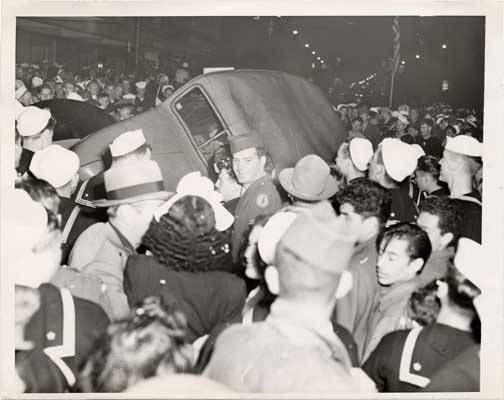
With the surrender of Japan in 1945, bringing with it the close of the Second World War, there was much rejoicing in the Allied nations. However, while celebrations on America's East Coast had more of a party atmosphere... On the West Coast it was considerably less so.
In California it meant that the troops and soldiers that were due to be shipped out discovered that they weren't going to be sent out to fight after, and they went... well...
In San Francisco thousands of servicemen, many of whom were teenagers, decided to on what has been called the deadliest riot in the city's history. As the San Francisco Chronicle put it in an article in 2015,
Thousands of frenzied, drunken revelers, an estimated 90 percent of them young Navy enlistees who had not served overseas, embarked on a three-night orgy of vandalism, looting, assault, robbery, rape and murder. By the time the “Peace Riots” burned themselves out on Friday morning, 13 people were dead, at least six women had been raped, 1,059 people were injured, and an incalculable amount of damage had been done to businesses, public buildings, streetcars, cars, traffic lights, signs, barber poles, marquees and everything else the rioters had gotten their hands on. They were the deadliest riots in the city’s history.
No effort was made to punish those who had committed the crimes by either city or military authorities, and while San Francisco District Attorney Edmund G. “Pat” Brown promised an investigation, but both it and a grand jury probe yielded nothing.
It had been unofficially decided by those in power to "move on" from the incident, despite the multiple deaths (many of which were hit-and-runs), reported rapes, and over 1000 people who had ended up in hospitals surrounding the Bay Area.
17 notes
·
View notes
Text

According to the writer of the 1943 horror/noir film the Seventh Victim, DeWitt Bodeen, the Satanic cult that serve as the movie's villains were in fact based upon an actual group he had met in New York's Greenwich village while he was researching for the film.
What is both amusing and kind of sad though, is that the group of occultists in question that Bodeen met were reportedly mostly elderly regular folk (if gothy), who divided their time between knitting and casting spells at Hitler to cause his downfall (something that proto-Wicca groups such as the New Forest Coven in Britain were also attempting separately).
Somehow via the magic of cinema this got interpreted as the occultist group being the kind of folk who, while pacifists, also have no compunction of manipulating outsiders who discovered their secrets into harming themselves. "Normal people" whose interests led to them becoming evil.
The film is reportedly still good (it being of the early 1940s Val Lewton horror era), and even had a cult following in the UK due to its "homoerotic undertones", can't help but feel that the writer could have taken the film in a different direction though. Even though the presence of the supernatural is vague (it's more of a mental/spirital dealie), the fact you had a story about magicians casting spells to hurt Hitler and somehow made THEM the bad guys is kind of sad.
That'll learn them for being different, I guess.

22 notes
·
View notes
Text

In the American city of St. Louis in mid-1950s, motorised blowers on the roof of the Pruitt-Igoe Housing Project (above), on schools, from the backs of trucks, and even attached to planes, dispersed a mixture of zinc cadmium sulphide with radioactive particulates across the predominantly lower income, African American neighbourhoods.
The justification given to city officials at the time was that it was intended to be an experiment in creating a kind of shield that could hide St Louis from potential Soviet bomber planes... When in actuality, the government revealed in 1994 that it had actually been a weapons test, and St Louis had been selected for the experiment due to its reported similarities to cities in the Soviet Union.
One person directly affected by this was Doris Spates, whose family lived on the top floor of the Pruitt-Igoe Housing development, where unbeknownst to them the Army was intentionally spewing hundreds of pounds of zinc cadmium sulfide into the air.
Three months after her birth, her father died. Four of her 11 siblings succumbed to cancer at relatively young ages, while Spat herself survived a bout of cervical cancer.
"I'm wondering if it got into our system," Spates said. "When I heard about the testing, I thought, `Oh my God. If they did that, there's no telling what else they're hiding."'
Likewise Mary Helen Brindell, who was around ten at the time of the tests, recalled how on a summer day playing baseball with other kids in the street when a squadron of green Army planes flew close to the ground and dropped a powdery substance. She went inside, washed it off her face and arms, then went back out to play.

Over the years, Brindell has battled four types of cancer -- breast, thyroid, skin and uterine.
"I feel betrayed," said Brindell, who is white. "How could they do this? We pointed our fingers during the Holocaust, and we do something like this?"
From my reading, there has been no move by the US government or military to apologise or provide compensation for victims of the experiments, with Pruitt-Igoe now long since demolished and its residents dispersed to the surrounding area.
12 notes
·
View notes
Text

In light of the current WGA and SAG AFTRA Strikes still going strong at well over 100 days at this point, I thought that it would be interesting to cover another strike by creative folk in Hollywood: the 1941 Disney Animators Strike.
For context, by 1941 the other major animation studios in Hollywood by this point had unionised, following the first being the 1937 Fleischer Studios Strike which produced the first union contracts, while over at Disney the studio remained a firm holdout.
However, due to a series of incidents, including Disney not following through on the promise to share profits from the phenomenally successful Snow White (trade papers at the time reported that Disney’s studio was going to distribute an estimated 20% of Snow White’s earnings among the studio’s 800 employees, the actual bonuses those artists received were equal to or less than what they had previously received for the studio’s short films, with some Snow White animators, including Art Babbitt, did not receive any bonuses for their work), the alienating behaviour of Gunther Lessing (the lawyer responsible for Disney copyrighting Micky Mouse), and other factors (such as Disney's management style consisting of playing favourites, stealing credit and so on) understandably led to tensions rising within the company.
Things came to a head in 1941, when Art Babbitt, his highest-paid animator, resigned as president of the Disney company union to join the Animation Guild. After Disney fired Art in retaliation three days later, the strike was on.
The strike went on for five weeks, and destroyed the somewhat communal atmosphere some felt that the studio had amongst its staff at the time. Support came in the form of labour organiser Herbert Sorrell, a former boxer, who had successfully lead some other Hollywood strikes, including one with the Screen Actors Guild in the mid-1940s that brought him into conflict with their president, a man by the name of Ronald Reagan.
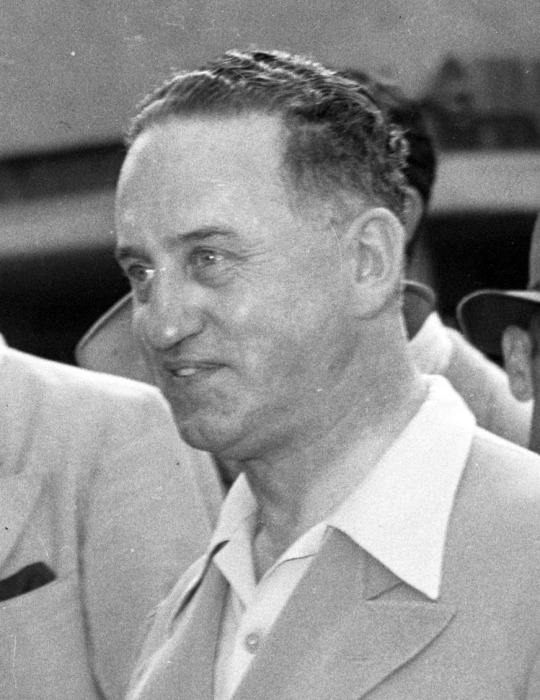
A notable incident involving Sorrell came when rumours of hired goons were coming to break the strike, leading to Sorrell send a gang of Lockheed aircraft mechanics with monkey wrenches to guard the tents of the striking animators which were pitched on the land across from the Disney Studio. It turned out to be merely a rumor and no damage was done, although Walt did reportedly almost get into a fight with Art
Eventually, FDR ended up having to send a federal negotiator to resolve the dispute, where they found in favour of the strikers in every issue. Disney, for his part, reportedly had been nearing a mental breakdown over the animators' "betrayal" left on a tour of Latin America to try and ease tensions.
Disney never forgave the strikers for the strike, and would maintain for years that rather than it being due to any mismanagement on his part, it was due to the animators being infiltrated by communists. Specifically, Herbert Sorrell, whom Disney would later report to the House of Un-American Activities Committee in 1947 as a communist infiltrator who was trying to turn his employees against him.

Y'know, so he learned nothing.
52 notes
·
View notes
Text

Ad for Penn Salt Chemicals, 1947 - "DDT Is Good for me"
Turns out it wasn't.
7 notes
·
View notes
Text
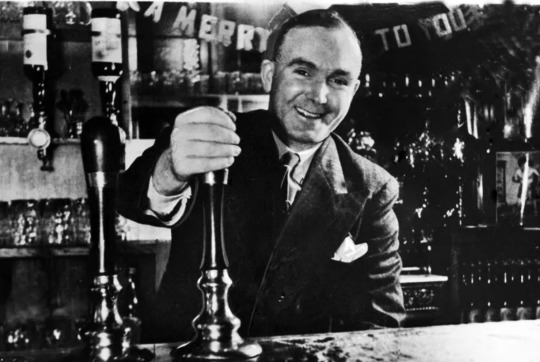
Over the course of 25 years, Albert Pierrepoint killed between 435 and 600 people, with his last being in 1956. He was Britain's most prolific hangman, and in late 1945 he was brought to Germany with a specific task: Executing Nazis.
A private man, both Albert's father and uncle had been hangmen before him, and over the course of his career he killed a variety of people, conventional criminals, serial killers (plus an innocent man a serial killer had framed for his crimes), and spies.
He didn't particularly like advertising his side-gig as someone who killed people on behalf of the state (for obvious reasons), but due to his reputation for efficiency (anecdotally he would figure out in his head the length of rope required to kill someone as quickly and relatively as possible just by eye) General Sir Bernard Montgomery, one of the senior figures in the British armed forces during WWII announced his involvement to the press.
Arriving in Germany, Albert was first assigned the task of executing the captured Nazi war criminals that had been operating the Bergen-Belsen Concentration Camps, including such people as the 22 year old Irma Grese, nicknamed Hyena of Auschwitz by her victims. He hanged the women individually, the men he hanged in pairs. Reportedly starting with the younger criminals first, under the reasoning that they would be the most scared.
Pierrepoint travelled several times to Hamelin, and between December 1948 and October 1949 he executed 226 people, often over 10 a day, and on several occasions groups of up to 17 over 2 days. After the Belsen executions, he was moved on to Nazi sympathisers, including the American-born fascist William Joyce, who had been granted the nickname Lord Haw-Haw due to his broadcasts across the English Channel in a fake posh accent trying to convince the British to surrender. He died 3 January 1946.
It is notable, however, that despite some claims to the contrary, Pierrepoint was not the hangman assigned to the war crime trials at Nuremberg (which fell under the jurisdiction of the Americans). It's notable in contrast to Pierrepoint, whose grim expertise in killing people with rope was such that he was hired to teach his methods to hangmen in Austria (reportedly their method was to let people strangle to death rather than their body weight breaking their necks like they did with his way), the American hire... err... wasn't that?
In fact, in contrast with Pierrepoint's... for lack for a better word consideration for the people he was killing, the American's choice, John C. Woods, had no prior experience as a hangman (reportedly lying that he had served as one as back in the US... in states where state-backed hangings had been phased out decades prior), and was notably at being kind of terrible at it? While Pierrepoint was all about killing people as quickly, painlessly and quietly as possible (both for the benefit of the prison staff as well as the victim), Woods deliberately botched executions to make the Nazis suffer as much as possible. Under the gallows operated by Woods, Nazis would dangle for minutes as they slowly strangled to death. Which considering the crimes that they had been convicted of, fair, but the contrast between the two men is fascinating.
Not least due to their later perspectives of their careers, with Albert returning to Britain and operating as a hangman for a further decade or so to retire to the pub in Preston that he had bought with the money from his executions back in the 1940s which he ran with his wife, Annie Fletcher.
It's notable that in the years following his retirement, he became opposed to the death penalty in Britain, and his obituary would quote his option opposed to the idea that capital punishment deterred crime,
'If death were a deterrent,' he wrote, 'I might be expected to know. It is I who have faced them at the last, young lads and girls, working men, grandmothers. I have been amazed to see the courage with which they take that walk into the unknown.
'It did not deter them then, and it had not deterred them when they committed what they were convicted for. All the men and women whom I have faced at that final moment convince me that in what I have done I have not prevented a single murder.'
Albert passed away in a nursing home in 1992 at the age of 87.... while with his former colleague John, his own view of his time as a hangman was a lot more glib.
I hanged those ten Nazis … and I am proud of it … I wasn't nervous. … A fellow can't afford to have nerves in this business. … I want to put in a good word for those G.I.s who helped me … they all did swell. … I am trying to get [them] a promotion. … The way I look at this hanging job, somebody has to do it. I got into it kind of by accident, years ago in the States …
For his part, John would himself die in 1950 at the age of 39, when he accidentally electrocuted himself to death while stationed in the Marshall Islands.
33 notes
·
View notes
Text

While the shadow Senator Joseph McCarthy left over the latter half of the 20th century in the United States is largely unavoidable, what is less well known are the circumstances under which his infamous witch hunts under the umbrellas of the Red and Lavender Scares (where he pursued people with real or imagined communist or lgbtq leanings) came to a close.
This itself is a story with several contributing factors.
McCarthy's Chief Counsel was a lawyer by the name of Roy Cohn (on the right on the main image, McCarthy on the left), a virulent anti-communist who was also the chief prosecutor for the Rosenburg Spy Case (arguing successfully for their executions despite even J Edgar Hoover thinking executing a mother with two young children would be unpopular). He was also a closeted homosexual, although his own leanings were an open secret among the US government, not that this deterred him from purging the US government of suspected gay and lesbian people (leading to 5000 people getting fired from their jobs).
Now, in November 1953, one of Cohn's associates by the name of G. Davies Schine (with whom Cohn had toured Germany previous to remove books by suspected communist authors from United States Information Agency libraries) was drafted into the US army. Cohn and McCarthy attempted to use their influence to pressure the army into having Schine stationed near to them in the US (some have read this as Cohn wanting his friend close by, others have suggested they were romantically involved, no confirmation is available that I can see, either way preferential treatment was demanded), and when the army told them no, the pair decided to threaten the army by turning their anti-communist hunts against them in retaliation.
And if you'd think that threatening the United States army in the early 1950s, when a former WWII general Dwight D. Eisenhower was president was a poor decision, you'd be right!
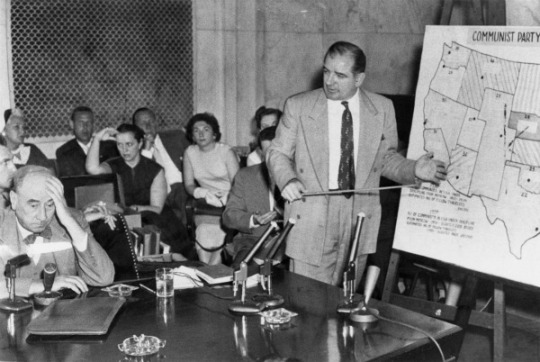
As such, in early 1954 the Senate Permanent Subcommittee on Investigations, usually chaired by McCarthy himself, was given the task of investigating whether McCarthy had indeed improperly sought preferential treatment. And unlike some of the other trials, the decision was made by ABC to televise the hearings, giving the American public their first view of what McCarthy's hearings were actually like as he turned his standard tricks against the army prosecutors.
You'd be right in thinking that it was more than a touch cynical that what it took to turn America against McCarthy was him attacking white, straight army dudes, but nevertheless that's what happened.
The army hired Boston lawyer Joseph Welch to make its case. At a session on June 9, 1954, McCarthy charged that one of Welch's attorneys had ties to a Communist organisation (the attorney in question, Fred Fischer, had been a member of the progressive National Lawyer's Guild). As an amazed television audience looked on, Welch responded with the immortal lines that ultimately ended McCarthy's career: "Until this moment, Senator, I think I never really gauged your cruelty or your recklessness." When McCarthy tried to continue his attack, Welch angrily interrupted, "Let us not assassinate this lad further, senator. You have done enough. Have you no sense of decency?".
Public support began to immediately drain from McCarthy, helped along by such things as the pioneering TV documentary series See It Now, where journalist Edward R Murrow (picture below) used clips of McCarthy's own behavior to underline how the senator had been exploiting the public's fear and spreading lies (such as implying the FDR and Truman administrations were treacherous) for his own political gain.
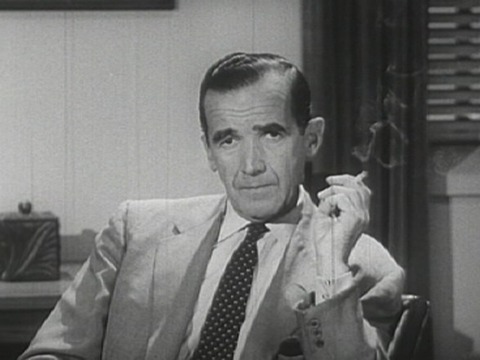
(Transcript of the episode here)
McCarthy was cleared of the charges, with sole responsibility being laid at the feet of Cohn, who resigned. By March of 1954, Joe's own Republican base in his home state of Wisconsin launched the Joe Must Go campaign, wishing to oust the senator for disrespecting the army, President Eisenhower, and for ignoring the plight of local dairy farmers facing price-slashing surpluses (y'know, the kind of issues he was elected to deal with rather than wandering around the United States harassing people for being gay, communist or being a gay communist).
He was eventually censured by the Senate on various charges that essentially amounted to making his colleagues look bad by association, and his political career limped along for a further two and a half years before finally dying of "Hepatitis, acute, cause unknown" on May 2, 1957. A diagnosis possibly made worse by both his heavy drinking and morphine addiction.
Schine, for his part in the proceedings, dropped out of politics following the hearings, where he entered the private sector, where among other things he made a cameo appearance in the 1966 Batman show (the Entrancing Dr Cassandra). He would eventually die in 1996 alongside his wife, and their 35 year old son in a private airplane accident.
And what of Roy Cohn... Well... While there are folk who'd go through an experience like this and try to either fade into obscurity or try to improve their image, Roy was not one of those people. He worked for the Mob in New York, the Catholic Church, Rupert Murdoch... and Donald Trump.

Cohn gathered a reputation for being willing to do whatever he felt was necessary to enrich either himself or to get his clients whatever they desired. This eventually led to his getting accused of theft, obstruction of justice, extortion, tax evasion, bribery, blackmail, fraud, perjury, and witness tampering. Indeed, Cohn's willingness to happily commit crimes for his clients has reportedly led to frustrations with Trump's recent legal trouble, with him being annoyed his current legal representatives aren't willing to do criminal stuff for them like Roy did back in the day.
Despite all of this though, Cohn remained a popular figure in conservative politics, even introducing Roger Stone to Trump, and was notably close friends with Ronald and Nancy Reagan, with whom he acted as an informal advisor and even ran Ron's presidential campaign in New York, Connecticut and New Jersey.
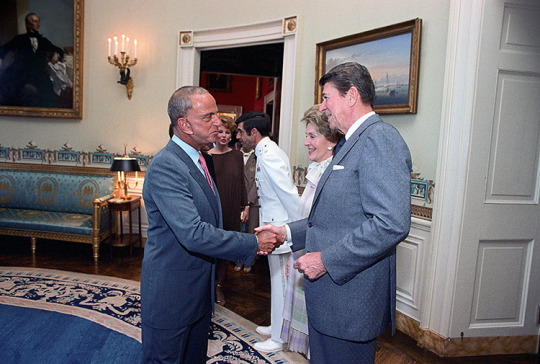
In 1986, Cohn was disbarred for, among other things, attempting to forge a client's will to make himself the beneficiary upon their death. On 2 August of that year, he died of complications from AIDS, having been cut off by Trump despite Cohn's loyalty (and help with lucrative mob contracts) over the years.
The IRS promptly seized his property, due to his owing the US government $7million in back taxes.
#irregular incidents#the cold war#crime#joseph mccarthy#roy cohn#history#american history#american politics#lgbtq#batman 1966
30 notes
·
View notes
Text

Los Angeles restaurateur Clifford Clinton was a surprising man in a lot of respects. Born 3rd August 1900, Clifford spent much of his childhood in China as his parents did missionary work, and after witnessing the starvation and violence following the 1898 to 1900 Boxer Rebellion, he supposedly made a vow to never let people go hungry.
As such, when he started his first cafeteria in 1931 (named Cliftons after smashing together his first and last name), he published his business policy on his cheques,
"Regardless of the amount of this check, our cashier will cheerfully accept whatever you wish to pay or you may dine for free."
This proved to be good timing, as when thousands of people fleeing to California out of desperation caused by the Great Depression, many found they were able to get a decent meal at Clifford's restaurants at a time when many Californians were actively hostile to the newcomers.
Additionally, Clifford bucked racist trends of the time by staunchly refusing to segregate his businesses, in a time when many restaurants refused to serve African Americans, Latinos and Asian Americans. When racist customers would complain about this in customer feedback forms, Clinton would publish their comments in the restaurants' newsletter and admonish them, at length.
Perhaps unsurprisingly, Clifford being very loud about his views lead to his drifting into the world of local LA politics, which at the time was a haven of corruption and vice under Mayor Frank Shaw, a man with the dubious claim to fame of possibly being the most corrupt mayor in the city's history.
Clifford first drew the ire of Shaw after he was hired to look at the state of the kitchens at the LA County General Hospital, where Clinton found significant amounts and of favouritism and waste, leading to his giving a list of recommendations of how to fix the budget and improve the quality of food being served. This unfortunately put him in Shaw's firing line, as he had once overseen the hospital, and he retaliated by siccing health inspectors on Clinton's establishments.

In turn, Clifford became an increasingly vocal critic of the corruption both in City Hall and in the LAPD, the latter of which (in addition to its own institutional problems) served as the enforcement arm of Shaw's administration. As such, he was hired to join Citizens Independent Vice Investigating Committee (CIVIC), an organisation aiming to eliminate organised crime within Los Angeles city governments.
To this effect, CIVIC hired a former cop by the name of Harry Raymond, a private investigator fired from the LAPD 90 days after being made Chief of Police due to his publicly saying he wanted to get rid of corruption, and set to work.
Shaw was accused of of influence peddling of city jobs, including police positions, and winking at brothels and gambling dens. The LAPD, meanwhile, began wiretapping Clinton's phones and in 1937 "someone" blew up Clifford's house with a bomb that had been placed in the kitchen.
This wasn't the only "mysterious" explosion, however, as three months later in January 1938, a car bomb grievously injured Raymond filling him with 186 pieces of shrapnel. In the subsequent trial, due to expert witness testimony by rocket scientist and Aleister Crowley devotee Jack Parsons, LAPD Captain Earle Kynette and two assistants, were convicted on four counts of conspiracy to commit murder, attempted murder, assault with intent to murder, and malicious use of explosives.

As Kynette was a member of the "Spy Squad" tasked with, well, spying on Clinton and his family, a line could firmly be drawn from the work of CIVIC and the attempted murders of Clinton and his family and that of Harry Raymond.
In the subsequent fallout from the trial, Chief of Police James Davis was forced to resign, while a Grand Jury investigation that finally linked Shaw with multiple vice rackets led to his being removed from office by a special recall election. The judge that oversaw the Grand Jury, Judge Fletcher Bowron, replaced him as mayor.
In 1944, Clifford funded a Caltech scientist Dr. Henry Borsook $5000 of his own money to produce a food additive that could be used to provide proper nutritional values for less than 5 cents a meal. Surprisingly, Borsook (in collaboration with French chef Mme. Soulange Berzceller) created Multi-Purpose Food (MPF), a flavourless high-protein food supplement that can be added to meals.
The profits from this invention, in addition to money gained from selling the restaurants to his children, led to Clinton and his wife founding the non-profit Meals for Millions in 1946, which distributed meals across the world to starving and malnourished people.
Clinton would eventually pass away in 1969, leaving the world somewhat better off than before. ...And that's not even getting into the sex aid business he was reportedly tangentially involved in with his mistress Terri Richmond, with whom Clifford's wife was allegedly aware of and supposedly fine with...
9 notes
·
View notes
Text

Twelve days into the Korean War, on 7th July 1950, FBI director J. Edgar Hoover approached President Harry S. Truman with a list of 12,000 names.
These names (97% of which were American citizens) were of people that Hoover felt should be indefinitely arrested and placed in concentration internment camps due to his claims that the people named were necessary to “protect the country against treason, espionage and sabotage" in the event that America were to go to war against the Soviet Union.
The letter wherein he proposed these arrests stated that eventually the interned people would be allowed to have a hearing. The hearing board would have been a panel made up of one judge and two citizens. But the hearings “will not be bound by the rules of evidence,” his letter noted.
Who would have been these people that Hoover wished to detain? His usual suspects. People with socialist or communist beliefs or sympathies (real or manufactured), pacifists, early members of the civil rights movement such as the African-American singer and actor Paul Robeson...
Truman, to his credit, didn't agree with Hoover's suggestion and chose to veto it, although Congress reportedly would later vote to overturn his veto.
This was one of several documents declassified in the mid-2000s that underlined for as terrible as J. Edgar Hoover was, there were still even worse things he wanted to do that even Truman (who was brought on as FDR's vice president because the Democrats thought he'd make them look tougher on communism than Roosevelt's former VP, the socially progressive Henry Agard Wallace*) was against it.
*Wallace wanted to do things like ending segregation, bringing about gender and racial equality, and establishing a national health service (like the UK eventually adopted several years later), so OBVIOUSLY he had to go.
217 notes
·
View notes